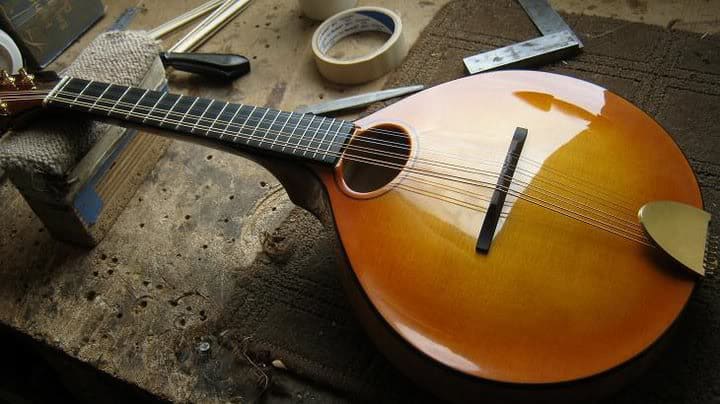
In this series of interviews, we talk to renowned Mandolin players, makers and enthusiasts.
Check out our comprehensive resource of Free Mandolin Tabs

It’s good to know that someone is keen enough to start a website for aficionados of this lovely instrument.
I hope that this very useful internet resource goes from strength to strength!
My own interest in the mandolin started a few years ago, when, after a lifetime of playing stringed instruments of one kind or another, I discovered a broken Neapolitan mandolin lying on the floor in the corner of a local junk shop. The side binding was loose, several bits of black & white kerfing were missing, the tortoiseshell scratchplate was damaged, and it had no strings or bridge, but it looked like it could be a bargain for £9!
I remember feeling a sense of achievement after restoring it to a reasonable standard of playability – after having stripped the body down to bare wood, gluing new pieces into place, and re-french polishing the body. I think it was the shape of the bowl that I liked the most – all those narrow curved strips: a bit like a miniature lute.
Anyway – that was it – 10 mandolins and 10 years later, and I think I’ve now just about managed to kick the collecting-habit.
So what is it about these lovely instruments that are so attractive? Well, to start with they have such a characteristic sound and they look so Italian…… remember the Disney film, “Lady and the Tramp” where the tramp-dog takes the posh-lady-dog for some spaghetti, and the 2 Italian restaurant owners serenade them round the back with an accordion and a Neapolitan mandolin? – Well, that’s the kind of music I associate with this instrument. (was the tune Santa Lucia?) They are often so beautifully decorated with mother-of-pearl inlays and intricate patterns.
So, in the years which followed my first restoration attempt, I managed to find Neapolitan mandolins all over the place – some broken and some going cheap in junk shops and flea markets. I suppose that the fact that often they were inexpensive to buy was also an attraction for me. In all the years that I’ve collected Neapolitan mandolins, I don’t think I’ve ever paid more than £100, and most have been in the £25 – £35 price range. Looking back, I suppose I quite enjoyed the getting-a-bargain-aspect of those junk shop discoveries!
I’ve often thought about why you rarely see anyone playing Neapolitan mandolins nowadays, and I suppose, as well as the tight fingerboard layouts, it’s the curved bowl which makes them difficult to hold and play – that is: without them slipping off your stomach. They say that you can now buy Stratocaster guitars with hollowing provided in the backs of the bodies to create a stomach fit (great for those of us who might have lost the flat body-profile of our youth!) – Unfortunately, you don’t get that snug fit with a bowl-back mandolin!
The other thing about my collection of Neapolitan mandolins is that I rarely play them – I’ve tried, but I just find the fingering too fiddly, the fret-spacing too miniscule, and I’d need to learn yet another new layout for the fingerboard. I suppose that I’m basically a bog standard guitarist, who’s dabbled a bit in slide tunings and played a bit of bass in my time, but can’t be bothered to get to grips with yet another tuning. Basically, the appeal of collecting mandolins is to do with the pleasure of mending and restoring things, and of owning such beautifully crafted instruments.
A couple of years ago, whilst on holiday in Kefalonia, (of “Captain Corelli’s Mandolin” fame), I spotted a Neapolitan mandolin hanging on the wall of a house. I fantasized about making an offer to whomever it belonged to. Imagine it – owning a Neapolitan mandolin from Kefalonia! So it was with some trepidation that I knocked on the door. I was informed by a woman that the owner was Valentino, a 92 year old Greek man, and that if I could call back later, he would be available.
A few hours later, my wife and I found ourselves knocking at the door once again. Valentino was introduced to us, took the mandolin off the wall and sat down to play it. The thing was – he couldn’t! He just kept strumming the out of tune strings and singing “poppa, poppa, poppa” in a monotone to the rhythm. We weren’t sure whether this was a traditional Kefalonian folk tune, or whether he was just winding us up! Anyway, we sat in respectful silence and nodded encouragement as he played and smiled back at us.
He’d written (in English) the words “LOVE, PEACE and HOPE” in blue biro on the wood on the front of the instrument – sentiments with which I could easily empathize, but, which I felt somewhat spoiled the appearance. He then stopped strumming and indicated (through his housekeeper / interpreter) that he would like my wife and me to dance for him while he played!
It was at this point that we thought we’d better go ……..so no Kefalonian-Neapolitan mandolin for me! Valentino later sent me a photo of himself (wearing a cowboy hat) playing the mandolin. It will always remind me of my lucky escape from having to engage in a public display of Greek dancing – it could have easily turned into a nasty international incident – remember those plane spotters!
Mandolin Interviews
Trevor Moyle Interview
Alon Sariel Interview
Dan Beimborn Interview
Kevin Macleod Interview
Dagger Gordon Interview
Alison Stephens Interview
Gary Peterson Interview
Ian Harris Interview
